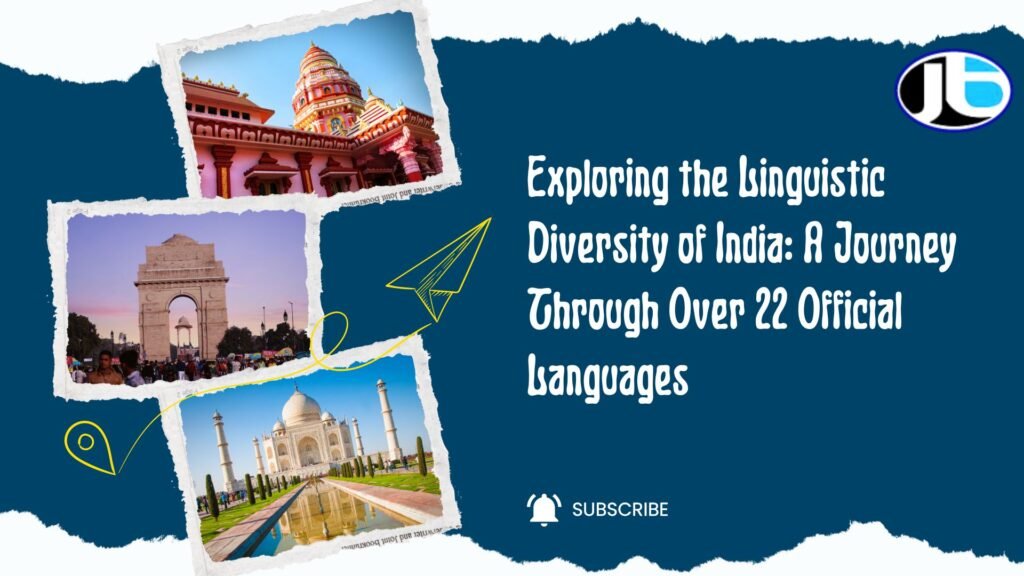India is a land of unparalleled linguistic diversity, reflecting its rich cultural, historical, and geographical mosaic. With 22 official languages recognized in the Indian Constitution under the Eighth Schedule, alongside hundreds of regional dialects and tribal languages, India is a linguistic treasure trove. Each language has its unique script, history, and cultural significance, contributing to the unity in diversity that defines the Indian subcontinent.
The Official Languages of India
India’s Constitution recognizes 22 official languages, ensuring that the linguistic heritage of the country is protected and promoted. These languages are used in various official capacities, such as in government communications, educational systems, and the judiciary. The languages are:
- Assamese (অসমীয়া): Spoken primarily in the northeastern state of Assam, Assamese is an Indo-Aryan language with a rich literary tradition dating back to the 14th century.
- Bengali (বাংলা): Predominantly spoken in West Bengal and the Indian state of Tripura, Bengali is one of the most widely spoken languages in India and the second most spoken language in the country after Hindi. It is known for its literary heritage, including contributions from Nobel laureate Rabindranath Tagore.
- Bodo (बड़ो): A Tibeto-Burman language spoken in the northeastern state of Assam, Bodo is the language of the Bodo ethnic community, and its inclusion in the official list reflects India’s recognition of tribal languages.
- Dogri (डोगरी): Spoken primarily in Jammu and Kashmir, Dogri is an Indo-Aryan language. It was included in the list of official languages in 2003, highlighting the region’s linguistic diversity.
- Gujarati (ગુજરાતી): The official language of Gujarat, Gujarati is an Indo-Aryan language with a rich history of literature, commerce, and trade.
- Hindi (हिन्दी): The most widely spoken language in India, Hindi is the official language of the central government and several states. It is an Indo-Aryan language and is written in the Devanagari script.
- Kannada (ಕನ್ನಡ): A Dravidian language spoken in Karnataka, Kannada has a rich literary history dating back over 1,500 years. It is one of the classical languages of India.
- Kashmiri (कॉशुर): Predominantly spoken in Jammu and Kashmir, Kashmiri belongs to the Dardic branch of the Indo-Aryan languages and is known for its poetic traditions.
- Konkani (कोंकणी): Spoken along the western coast of India, especially in Goa, Konkani is an Indo-Aryan language with influences from Portuguese due to Goa’s colonial past.
- Maithili (मैथिली): Spoken in Bihar, Maithili is an Indo-Aryan language with a distinct cultural and literary tradition.
- Malayalam (മലയാളം): A Dravidian language spoken in Kerala, Malayalam has a long history of literature and is renowned for its classical and modern poetry.
- Manipuri (মেইতেই লোন): The official language of the state of Manipur, Manipuri (also known as Meitei) is a Tibeto-Burman language.
- Marathi (मराठी): The official language of Maharashtra, Marathi is an Indo-Aryan language with a deep literary tradition and historical significance, especially during the Maratha Empire.
- Nepali (नेपाली): Spoken in parts of India, particularly in Sikkim and the Darjeeling district of West Bengal, Nepali is an Indo-Aryan language.
- Odia (ଓଡ଼ିଆ): Spoken in Odisha, Odia is an Indo-Aryan language known for its classical literature. It was declared a classical language by the Indian government in 2014 due to its long literary history.
- Punjabi (ਪੰਜਾਬੀ): The official language of Punjab, Punjabi is an Indo-Aryan language written in the Gurmukhi script and is widely spoken across northern India.
- Sanskrit (संस्कृतम्): Although no longer a commonly spoken language, Sanskrit is the liturgical language of Hinduism and the classical language of India, with a vast body of religious and philosophical literature.
- Santali (ᱥᱟᱱᱛᱟᱲᱤ): A Munda language spoken by the tribal Santali people in parts of Jharkhand, Odisha, and West Bengal, Santali uses its own Ol Chiki script and was added to the list of official languages in 2003.
- Sindhi (सिन्धी): An Indo-Aryan language spoken by the Sindhi community, primarily in western India. It has historical ties to the Sindh region (now in Pakistan) and is known for its literary and cultural contributions.
- Tamil (தமிழ்): A Dravidian language spoken in Tamil Nadu, Tamil is one of the oldest languages in the world and has been classified as a classical language of India due to its ancient literary history.
- Telugu (తెలుగు): Spoken in Andhra Pradesh and Telangana, Telugu is a Dravidian language with a rich history of literature and culture. It is also one of India’s classical languages.
- Urdu (اردو): An Indo-Aryan language written in the Perso-Arabic script, Urdu is widely spoken in northern India, particularly in Jammu and Kashmir, Uttar Pradesh, Bihar, and Telangana.
Linguistic Diversity Beyond the Official Languages
In addition to these 22 languages, India is home to hundreds of regional dialects, tribal languages, and endangered tongues that reflect the country’s diverse cultural landscape. For instance, languages like Tulu, Konkani, Bhili, and Gondi have vibrant communities of speakers, even though they aren’t recognized as official languages at the national level.
Each state in India often recognizes its regional languages for educational purposes, official documents, and day-to-day communication. This regional linguistic diversity is protected under India’s federal structure, where individual states have the power to declare their own official languages based on the predominant spoken language of the area.
The Role of English in India’s Linguistic Landscape
Although not one of the 22 constitutionally recognized languages, English serves as an associate official language and is widely used in government, business, education, and media. English acts as a link language across the country, especially in multicultural urban centers where speakers of different languages coexist. Many Indians are bilingual or multilingual, often speaking English in addition to their regional language(s).
Preserving and Promoting India’s Linguistic Heritage
India’s linguistic diversity is one of its most unique features, but it also faces challenges. Some tribal and regional languages are at risk of extinction due to the dominance of larger languages and globalization. Efforts are being made by both governmental and non-governmental organizations to preserve these endangered languages through educational programs, documentation, and promoting linguistic pride.
The Indian government’s National Translation Mission aims to translate literary and academic works into various Indian languages, making knowledge accessible across linguistic boundaries. Additionally, language academies and cultural institutions across the country work tirelessly to promote the use of regional languages in literature, media, and education.
Conclusion
India’s linguistic diversity is a reflection of its multifaceted culture, history, and heritage. The 22 official languages recognized by the Indian Constitution are just a small representation of the country’s linguistic wealth. From the ancient script of Sanskrit to the modern literary tradition of Bengali, each language carries with it stories, knowledge, and wisdom passed down through generations. By embracing and preserving this linguistic diversity, India continues to celebrate its “unity in diversity,” where each language forms a thread in the grand tapestry of the nation.
Introduction to India’s Linguistic Diversity
India is a remarkable mosaic of cultures, traditions, and linguistic expressions, setting it apart as one of the most linguistically diverse countries in the world. With over 22 officially recognized languages, the linguistic landscape of India reflects the social, ethnic, and cultural pluralism inherent to its society. Language serves not merely as a means of communication but also plays a critical role in shaping individual and community identity. It fosters a sense of belonging and continuity among different groups, encapsulating the values, histories, and worldviews that define them.
The constitution of India acknowledges this diversity through the Eighth Schedule, which enshrines the official status of various languages. Languages such as Hindi, Bengali, Telugu, Marathi, Tamil, Urdu, and Punjabi are more than mere tools of communication; they are vessels of traditions, rituals, and the essence of local and regional identities. The presence of multiple languages encourages a rich tapestry of literature, music, and oral traditions, each reflecting varied societal attributes and historical narratives.
Moreover, India’s linguistic diversity is not just a matter of the number of languages spoken, but also pertains to countless dialects and variants that coexist within these languages. This multiplicity creates a dynamic interplay of linguistic interactions that enriches social experiences and promotes intercultural dialogue. In every corner of the nation, languages manifest varied forms of expression, be it in street signs, folk songs, or literary works, affirming their vital role in everyday life.
The exploration of India’s linguistic plurality serves as a testimony to the country’s historical richness and cultural complexity. As we delve deeper into the various languages and their significance, it becomes evident that language is an integral thread weaving together the fabric of Indian society.
The Role of Language in Indian Society
Language plays a pivotal role in shaping the fabric of Indian society. With over 22 official languages, it acts as an essential medium for communication among different communities, facilitating interaction across various social strata. Each language brings with it a unique set of linguistic attributes, cultural nuances, and traditions, enriching the overall communication experience. Language fosters connection, allowing individuals to convey thoughts, emotions, and information effectively while ensuring that diversity is embraced and celebrated.
In a nation as vast and culturally rich as India, language becomes more than just a means of communication; it serves as a conduit for cultural expression. Folk tales, poetry, proverbs, and songs, embedded in various regional languages, narrate the historical experiences and values of communities. These linguistic traditions help preserve and promote local cultures, contributing to a shared identity among speakers. Additionally, languages are integral to the transmission of customs and rituals, playing a crucial role during ceremonies and festivals, thereby reinforcing bonds within communities.
Moreover, language has become a significant element in the realm of education and social mobility. Proficiency in multiple languages can open doors to better job opportunities, enabling individuals to engage in diverse fields. This linguistic versatility is essential in urban settings, where interactions across different linguistic groups are commonplace. Furthermore, the role of language in the digital age has become increasingly vital. Technology has enabled the rise of regional content, giving voice to various languages online. This evolution helps bridge gaps among different linguistic communities, promoting inclusivity and enhancing social interactions.
Overall, the integral role of language in Indian society extends beyond mere communication; it is deeply interconnected with culture, traditions, and social dynamics, fostering unity while celebrating diversity.
Overview of the 22 Official Languages
India is renowned for its rich tapestry of languages, reflecting the country’s diverse cultural heritage. The Constitution of India recognizes 22 official languages, which facilitate communication across different regions and among various communities. Hindi is the most widely spoken language, serving as a primary means of communication for nearly 44% of the population. Bengali follows, predominantly spoken in the state of West Bengal and parts of Assam, boasting around 9% of the nation’s speakers.
Telugu and Marathi also hold significant positions, with Telugu largely spoken in Andhra Pradesh and Telangana, and Marathi predominant in Maharashtra. Both languages have millions of native speakers and vibrant literary traditions. Tamil, another major language, is prominent in Tamil Nadu and among the Tamil diaspora globally, with its roots tracing back thousands of years.
Urdu is extensively spoken in several northern states, showcasing a rich literary heritage tied to Indian culture. Gujarati, the primary language of Gujarat, enjoys a large following as well, while Malayalam, spoken in Kerala, features a distinct script and a unique set of dialects.
Kannada, the official language of Karnataka, Odia in Odisha, and Punjabi in Punjab also add to the linguistic mosaic, each with substantial speaker populations. Additionally, Assamese, Maithili, Santhali, Kashmiri, and Konkani represent the languages spoken in their respective regions, enriching the overall linguistic landscape. Dogri, Manipuri, and Nepali further showcase the diversity found in the northeastern parts of India, alongside Sanskrit, which holds historical significance as an ancient language.
All these languages reflect not only the diversity of India’s people but also the geographical distribution of cultural practices, making the study of such languages essential for appreciating the nation’s multifaceted identity.
Historical Evolution of Languages in India
The linguistic landscape of India is a rich tapestry woven from its extensive history, influenced by the subcontinent’s complex sociopolitical changes and migrations. The origins of India’s languages can be traced back to ancient times, with the Dravidian languages predominantly spoken in southern India and the Indo-Aryan languages central to the northern regions. The divine ancient scriptures, the Vedas, composed in Sanskrit, mark the beginning of recorded Indian linguistic history, dating back over 3,000 years. This ancient language served as a reference point for many subsequent languages in the region.
Throughout history, various dynasties have played a crucial role in shaping the linguistic fabric of India. The Maurya and Gupta empires, for instance, were instrumental in propagating Sanskrit, establishing it as a language of administration and scholarship. The arrival of Persians and later Mughals introduced Persian and Urdu, further enriching the linguistic diversity. These languages became popular, primarily in the courts and among the elite, thus creating a linguistic blend that reflected the pluralistic nature of Indian society.
The impact of colonial rule cannot be overlooked when discussing the evolution of Indian languages. The British colonial administration’s policies on education and administration favored English, leading to a decline in the prominence of many indigenous languages. This period also saw a revival of interest in regional languages as movements emerged advocating for their recognition and preservation. Post-independence, Indian linguistic policy has evolved dramatically, with the enactment of the Official Languages Act in 1963, recognizing 22 languages. The continuous promotion of these languages underscores India’s commitment to linguistic diversity while fostering cultural identity.
Language and Identity: A Cultural Perspective
The intricate relationship between language and cultural identity is particularly pronounced in India, a country characterized by its vast linguistic diversity. Each of the nation’s officially recognized 22 languages serves not merely as a medium for communication but also as a vessel of identity that fosters a sense of belonging among its speakers. Linguistic ties unite members of different communities, reinforcing social bonds and communal pride.
Language plays a pivotal role in shaping an individual’s cultural framework. For many, the language they converse in is directly linked to their heritage, customs, and traditions. For instance, speaking a regional language may evoke a sense of nostalgia, connecting individuals to their ancestral history and cultural practices. This linguistic connection often serves as a foundation for participants in local festivals, rituals, and celebrations, allowing them to express their unique identities through language-specific practices.
Furthermore, this multifaceted connection manifests in interpersonal relationships, influencing how individuals interact within and outside their communities. In many Indian cultures, greetings, expressions of affection, and even conflict resolution often hinge on language usage. The nuances embedded in a language can transmit emotions and social hierarchies that are critical to understanding interpersonal dynamics.
Challenges Facing Multilingualism in India
India is a nation celebrated for its linguistic diversity, housing over 22 officially recognized languages. However, this rich tapestry of languages encounters a myriad of challenges that threaten to alter the multilingual landscape. One significant challenge is the preservation of lesser-known languages. Many indigenous languages are at risk of extinction, as speakers shift toward more dominant languages due to societal pressures and economic opportunities. This linguistic shift not only undermines heritage but also results in the loss of cultural identity and traditional knowledge encapsulated within these languages.
Moreover, the dominance of certain languages, notably Hindi and English, poses a significant obstacle to linguistic equality. As these languages gain prominence in education, media, and governance, speakers of regional languages often find themselves marginalized. This situation fosters an environment in which the languages of dominant groups gain prestige, while many local languages face neglect and diminished usage in everyday communication. The hierarchical structure of language prominence in India not only perpetuates social inequalities but also exacerbates tensions among different linguistic communities.
Furthermore, language policy and educational frameworks in India contribute to these challenges. While the intention of promoting multilingualism exists, inadequate implementation and lack of resources hinder effective language education. Many educational institutions prioritize instruction in dominant languages at the expense of regional languages, leading to generational shifts in language use and proficiency. This policy deficiency can lead to a cycle where young speakers lack motivation to learn their mother tongues, further endangering their survival.
Globalization intensifies these challenges, as it encourages the adoption of global languages for economic and cultural integration. The influx of global media and communication influences often leads to a preference for languages like English, which has become synonymous with progress and modernity. In this global context, the struggle for linguistic preservation becomes increasingly complex, necessitating urgent attention to foster an environment that values and protects India’s rich linguistic heritage.
Government Policies and Language Promotion
India, renowned for its rich linguistic diversity, has implemented various government policies to promote and preserve its official languages. The Eighth Schedule of the Indian Constitution stands as a pivotal framework that recognizes twenty-two languages, reflecting the nation’s commitment to linguistic representation and cultural preservation. This recognition not only legitimizes regional languages but also plays a crucial role in bolstering national identity and unity among its diverse population.
One of the key initiatives in this context is the promotion of regional languages in education. The Government of India has actively encouraged schools to integrate local languages into their curricula, creating an educational environment that values and nurtures linguistic heritage. This approach aims to enhance the learning process, as studies suggest that students often perform better when taught in their mother tongue during the foundational years of education. Moreover, initiatives such as the ‘Samagra Shiksha Abhiyan’ focus on educational development, ensuring that children across states have access to quality education in their respective languages.
In addition to educational policies, various government-sponsored programs strive to promote multilingualism and foster appreciation for regional languages. The ‘Language Satellite’, for instance, has been a successful venture designed to promote language development and provide resources for linguistic research. Additionally, events such as the ‘International Mother Language Day’ have been celebrated widely, drawing attention to the significance of preserving linguistic identities in a rapidly globalizing world.
The promotion of linguistic diversity is also evident through media and cultural sponsorship programs that elevate regional languages. Government initiatives support publications, films, and festivals that highlight local languages, encouraging artistic expression and fostering a sense of pride in cultural identity. Through these diverse approaches, the Indian government endeavors to solidify the role of regional languages not only as vehicles of communication but also as essential components of the nation’s cohesive identity.
The Future of Languages in India
As India strides confidently into the modern era, the landscape of its linguistic diversity faces both challenges and opportunities. The rapid pace of globalization and technological advancement has a profound impact on the 22 officially recognized languages of India. While languages like Hindi and English are gaining prominence and becoming more entrenched in everyday interactions, several regional and indigenous languages are at risk of fading away. The future of these languages hinges on concerted efforts for preservation and revitalization, aimed at ensuring these valuable cultural assets do not become relics of the past.
Technological innovation is poised to play a crucial role in shaping the future of languages in India. With the advent of mobile applications and digital platforms, tools for learning and preserving languages have become more accessible than ever. For example, language learning apps now offer courses in several Indian languages, catering to the rising interest in regional identities among both locals and non-Indians. Furthermore, social media provides a vibrant space for speakers of endangered languages to communicate and share their cultures, fostering a sense of community and encouraging linguistic pride.
Education systems in India are also increasingly acknowledging the importance of linguistic diversity. Bilingual or multilingual education programs promote language learning from an early age, enabling children to connect with their heritage while simultaneously equipping them with skills necessary to thrive in a globalized context. Efforts to compile dictionaries and glossaries, coupled with academic research documenting endangered languages, illustrate the awakening to the significance of comprehensive language study.
In conclusion, the future of India’s linguistic diversity is a complex tapestry of challenges and possibilities. While modernization and technological advancements pose risks to the survival of certain languages, proactive measures in education and digital preservation hold promise for revitalization efforts. Embracing linguistic diversity as a vital component of India’s cultural identity will play a pivotal role in ensuring that its myriad languages continue to thrive in the years to come.
Conclusion: Celebrating India’s Linguistic Heritage
India’s linguistic diversity is a cornerstone of its cultural identity, embodying a rich tapestry woven from centuries of history, tradition, and change. The nation’s status as home to over 22 officially recognized languages is not merely a reflection of administrative categorization; it showcases the profound importance of communication in shaping community bonds and cultural understanding. Each language carries with it distinct traditions, literature, and knowledge systems, contributing to a vibrant collective heritage that enriches both individual and national identity.
Celebrating this diversity goes beyond mere acknowledgment; it is a call to preserve and promote the varied linguistic landscapes that comprise India. Multilingualism not only enriches personal experiences but also fosters mutual respect and understanding among different communities. Embracing multiple languages opens pathways for dialogue and increases the appreciation of cultural nuances, allowing for deeper connections in an increasingly globalized world.
Moreover, preserving linguistic heritage is essential for future generations. As globalization intensifies, some languages face the risk of decline or extinction. Therefore, it is crucial for individuals, communities, and policymakers to engage actively in initiatives aimed at protecting and revitalizing these languages. This may include educational programs, cultural workshops, and collaborative projects that highlight the significance of India’s myriad tongues.
By appreciating and valuing India’s linguistic diversity, we not only affirm the significance of each language but also enhance our understanding of the country’s multifaceted social fabric. Ultimately, India’s linguistic heritage should be celebrated as a vital asset, fostering intercultural dialogue and enriching the collective experience of its people. Encouraging engagement with diverse languages paves the way for a more inclusive and harmonious society, underscoring the beauty of India’s linguistic landscape.











